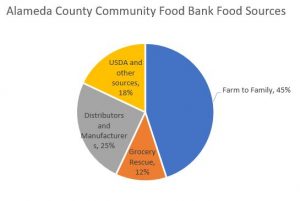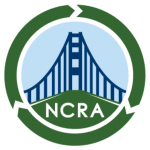By NCRA Food Waste Reduction Committee
For our report, Commercial Food Waste Reduction in Alameda County, we documented the amount of surplus food that was rescued and distributed in Alameda County. We estimated that about 5.7 million pounds of surplus food that was generated within the county was redistributed to feed hungry people in Alameda County in 2016.
A major player is the Alameda County Community Food Bank. As we documented in our report, the Food Bank runs the grocery rescue or Food Recovery Program which matches grocery stores to agencies (like food pantries) that distribute the surplus food (like individually wrapped salads, sandwiches, produce and food staples). Over 3.6 million pounds of food from over 100 donors was redistributed through the grocery rescue program in 2016. This grew to over 4 million pounds in 2017.
Since we published our report in July 2017, we learned about other sources of surplus food obtained by the Food Bank.
The Food Bank receives donations from large manufacturers and retail distributors, some of which might otherwise have been disposed. The Local Donation Program from Distributors and Manufacturers accounts for over 25% of the food that they distribute. This compares to about 12% from the grocery rescue program. The Local Donation Program has grown by 2.2 million pounds over the last two years, with last fiscal year totaling 6.2 million pounds. About 40% of this product is produce, and overall, it consists of a fair mix of dry goods, fresh bread/tortillas, fresh dairy, fresh juice, frozen product (meat, meals, etc.). The Food Bank works with about 20 donation partners throughout the county weekly, and averages about 630,000 pounds of surplus food redistributed per month.
The Local Donation Program has grown by 2.2 million pounds over the last two years, with last fiscal year totaling 6.2 million pounds. About 40% of this product is produce, and overall, it consists of a fair mix of dry goods, fresh bread/tortillas, fresh dairy, fresh juice, frozen product (meat, meals, etc.). The Food Bank works with about 20 donation partners throughout the county weekly, and averages about 630,000 pounds of surplus food redistributed per month.
About 45% of the food that the Food Bank distributes comes from the California Association of Food Banks Farm to Family Program which distributed 164 million pounds of surplus produce to 43 food banks statewide and partnered with more than 135 farmers to access 44 different crops (which might otherwise have been wasted or ploughed under). This surplus food is generated outside of Alameda County, but feeds hungry people in county and throughout the state.
Senate Bill 1383 requires local jurisdictions to up the ante on food rescue and ensure that 20% of currently disposed edible food is recovered for human consumption in 2025. As the state identifies priorities for food rescue, it will need to consider the role of the large, traditional sources of surplus food (farms, manufacturers, and distributors) compared to the smaller, more difficult-to-address sources of surplus food (such as restaurants, schools, corporate cafeterias, and caterers).
Thank you Caroline Chow, Food Resource Development Coordinator, Alameda County Community Food Bank for contributing to this piece.
